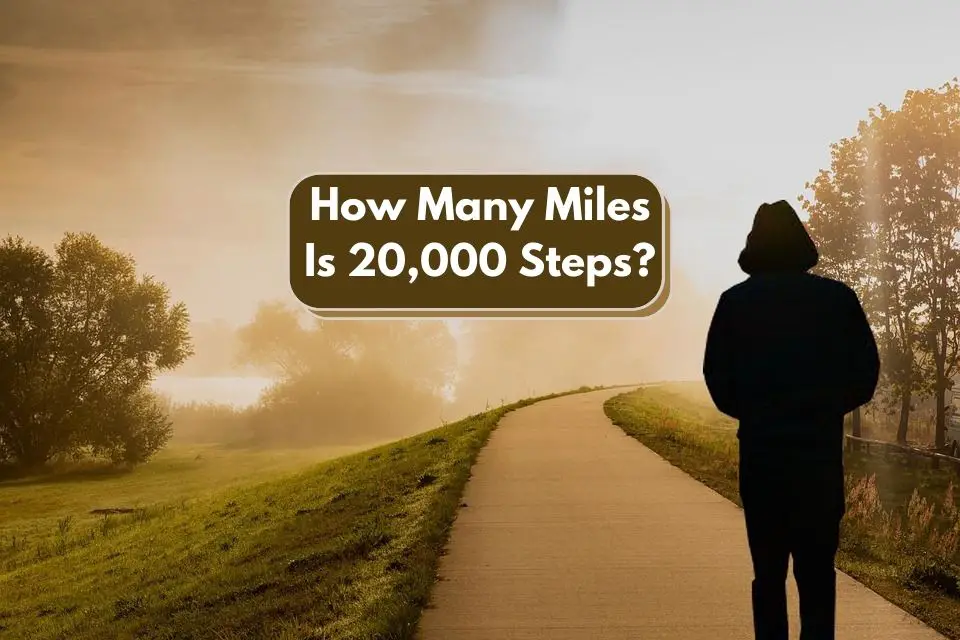If you’re using a fitness tracker and participating in challenges with your friends, or you’re just curious about how far you’ve traveled while hiking, you’re probably wondering: how many miles is 20,000 steps?
20,0000 steps is between 8.8 and 9.2 miles depending on the length of your stride, so we can safely say that 20k steps equals approximately 9 miles.
There are a few factors that go into figuring out how many miles is 20k steps, which we’ll cover in this guide.
How Many Miles Is 20,000 Steps?

As we covered, 20,000 steps averages out to around 9 miles based on the average stride length.
According to a study from the University of Oklahoma, the average stride length is around 31.1 inches for males and around 25.98 inches for females.
There are 63,360 inches in a mile.
So to convert 20,000 steps to miles, we’ll use the following formulas:
20,000 Steps To Miles For Males
We’ll take the average male stride length of 31.1” and multiply by 20,000.
31.1 x 20,000 = 622,000
Next, we’ll divide the total inches in 20,000 steps (622,000) by the inches in a mile (63,360) to convert 20k steps to miles.
622,000 / 63,360 = 9.81 miles
So for men with an average stride of 31.1 inches, they will need to walk 9.81 miles to reach 20,000 steps.
20,000 Steps To Miles For Females
We’ll take the average male stride length of 25.98” and multiply by 20,000.
25.98 x 20,000 = 519,600
Next, we’ll divide the total inches in 20,000 steps (519,600) by the inches in a mile (63,360) to convert 20k steps to miles.
519,600 / 63,360 = 8.2 miles
So for women with an average stride of 25.98 inches, they will need to walk 8.2 miles to reach 20,000 steps.
20,000 Steps To Miles: 5 Key Factors To Consider

So how far is 20,000 steps? It all comes down to your stride length.
There are a few different variables that affect the length of your stride.
Let’s cover these variations in stride and what effects they have on how far 20,000 steps will take you.
- Your Gender
Males have a longer average stride (31.1”) than females (25.98”), so the amount of distance they’ll travel over 20,000 steps will naturally be longer.
- Your Height
Generally speaking, the taller someone is, the longer their stride will be.
Although there are variations in proportions (two people of the same height can have different arm and leg lengths, for example), the general ratio still applies across most people.
Longer legs means longer steps, which means more miles in 20,000 steps for taller people.
- Your Age
18 to 50 year-old adults will have the longest step lengths, meaning they will have more miles in 20,000 steps than children or those over 50.
This is because children are shorter, and shorter legs means shorter step lengths, while those over 50 often use less power in their ankles when walking, resulting in shorter step lengths.
- Injury Or Illness
This may seem obvious, but if someone is dealing with an injury or suffering from an illness, they are more likely to walk at a gingerly pace, resulting in shorter step lengths.
This will mean that someone who is ill or has an injury will travel less miles in 20,000 steps.
- The Terrain
Almost everyone deals with variations in terrain throughout the day.
Even if you’re working in an office, you still will have stairs or turns to navigate – all of which affect your step length.
This rule goes double for outdoor activity, as steep inclines, declines, uneven terrain, and wet or muddy situations all will result in shorter step lengths, making the total miles you travel over 20,000 steps shorter.
See Related:
How Many Miles is 25,000 Steps?
How Many Miles is 30,000 Steps?
How Far Is 20,000 Steps? Wrapping Things Up
What is 20,000 steps in miles? The average person will travel 9 miles when taking 20,000 steps.
The main factor that determines how many miles is 20,000 steps is the length of each person’s step, which is affected by factors such as gender, height, age, the terrain, and if the person has any illness or injury.
Have you determined your step length? How many miles to get to 20,000 steps for you?
Let us know in the comments below.
Check out our other related guides while you’re here:

